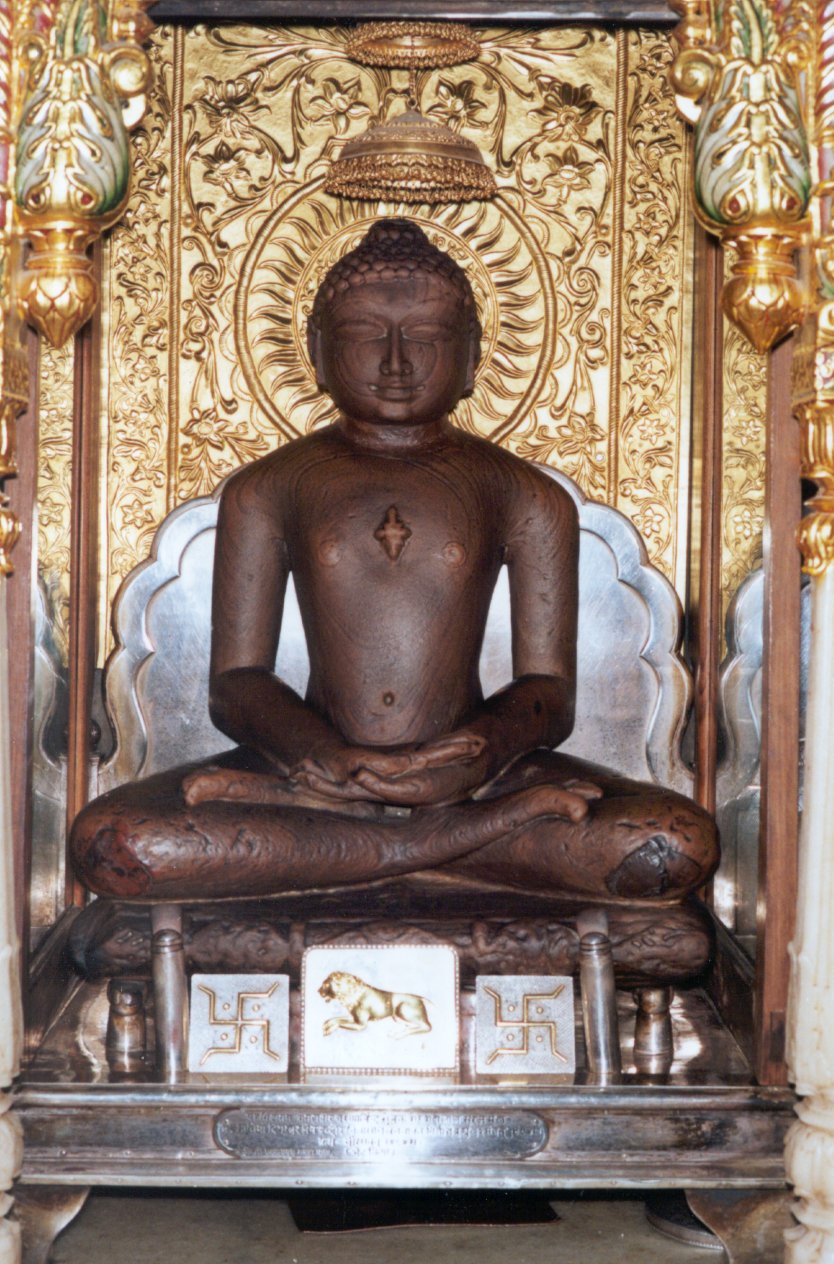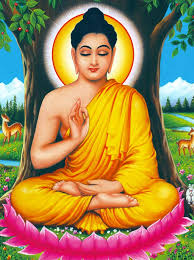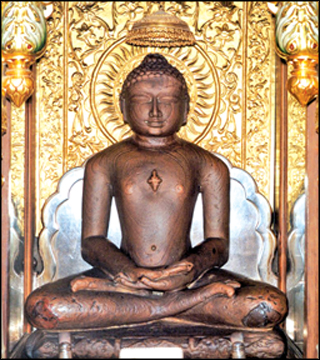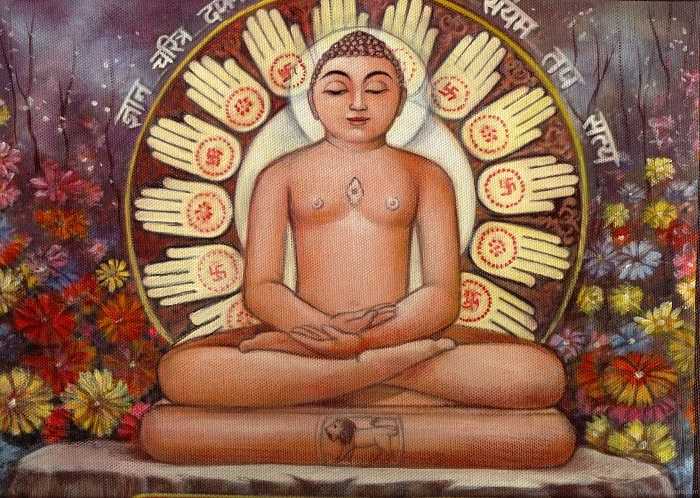- Home
- Religions in India
- Jainism
- Mahavira
Mahavira
Updated on 24-05-2022
Mahavira
Quick Facts:
Name: Vardhamana
Religion: Jainism
Born: 599 B.C.
Birth Place: Kshatriyakund, Vaishali
Parents: Father- Siddhartharaja, Mother- Trishala
Spouse: Yashodha
Children: Priyadarshana ( daughter)
Predecessor: Parshvanatha
Titles: Mahavira, Tirthankara, Jina
Died: 527 B.C.
Mahavira was the 24th Tirthankara in Jainism. His predecessor Thirthankaraha Parshavantha was said to have lived 250 years before Mahavira. Mahavira was born in a royal family in the early 6th century B.C.
His mothers name was Trishala and father was Siddhartha. When Vardhamana/ Mahavira was 30 years old, he left his comfort life at home in search of spiritual awakening. On attaining Kvela Jnana, Mahavira traveled extensively all over India preaching Jain philosophy for a period of 30 years.
It is said that Jainism existed even before Indus Valley Civilisation. The seals engraved by the people of Indus Valley Civilisation seem to suggest that this religion existed at the time of Indus Valley Civilisation.
The scriptures in Vedic period also make references to the tirthankaras of Jain prophets including Lord Rishabadev, Lord Aristanemi and Lord Ajitanath. It is believed that Mahavira who taught Jainism in ancient India was an older contemporary of Gautama Buddha.
Early Life of Mahavira
Mahavira was born in a royal family of Vaishali which is located in the modern state of Bihar, India. Mahavira also known as Vardhamana was born to the Kshatriya royal family. His father’s name was Siddhartha and mother’s name was Trishala of Ikshvaku dynasty.
Siddhartha was the king of Ikshvaku Dynasty and Trishala was the Queen. The Ikshvaku dynasty was founded by first Tirthankara Rishabhanatha. Mahavira was born in 599 B.C. According to Hindu calendar he was born on the thirteen day of the rising moon in the month of chaitra and Vira Nirvana Samvat calendar. According to the Gregorian calendar Vardhamana was born in the month of March- April which is celebrated as Mahaveera Jayanti.
According to the Acharangha Sutra bothTrishala and her husband were followers of 23rd Thirtankara Parshava. During her pregnancy Trishala had auspicious dreams about lion, elephant, flowers, kalasha and many more.
It is believed that mothers of tirthankaras would see such dreams during pregnancy. It is understood from the Jain texts that after the birth of Mahavira Lord Indra came to his birthplace along with 56 digkumaries anointed Mahavira and did Abhisheka on Mount Meru and left the place
Also Read about
Mahavira grew up as a brave boy with all royal luxuries and comforts at home. The Svetambara tradition believes that Mahavira was married to Yasodha at a young age and also had a daughter with her however Digambara tradition says that Mahavira was not married to Yashoda.
Renunciation
When Mahavira was 30 years, he renounced the worldly pleasures for finding the cause of his existence. Mahavira practiced very hard penance for 12 years to take away all the karmas and the attachments to the worldly pleasures. He undertook severe fasts, did meditation and also discarded all his clothes and remained naked.
When Mahavira was 30 years, he renounced the worldly pleasures for finding the cause of his existence. Mahavira practiced very hard penance for 12 years to take away all the karmas and the attachments to the worldly pleasures. He undertook severe fasts, did meditation and also discarded all his clothes and remained naked.
According to Kalpa sutra Mahavira traveled extensively to different places like Vaishali, Champapuri, Nalanda, Mithila, Badrika, Shravasti and Pawapuri . He spent the next thirty years travelling extensively on bare foot all over India preaching the eternal truth.
After following strict penance for 12 long years Mahavira was able to achieve Kevala Jnana or enlightenment or omniscience under a Sala tree at the age of 43 years. He attained kevala Jnana or Omniscience near the banks of River Rijupalika near Jrimbhikagrama. Jains believe that Mahavira had the most auspicious body after he attained omniscience.
After attaining kevala jnana Mahivara travelled extensively teaching the five important Jain vows and the Jain Philosophy. According to Svetambaras Mahavira travelled for thirty years all over India to teach his philosophy but according to Digambaras Mahavira did not travel and stayed in Samavasarana ( a divine preaching Hall of the tirthankaras) and preached his philosophy for his followers.
Disciples of Mahavira
His first disciples were 11 students from the Brahmin community. These eleven students were known as Ghandharas. Gautama was the leader of Ghandhara. Other members of Gandharas were Prabhasa, Agnibhuti, Vayubhuti, Akampita, Arya Vyakta, Sudharman, Manditapura, Mauryaputra, Acalabhraataa and Metraya.
Lord Mahavira’s three important preachings for his chief disciple were Emergence, Destruction and Permanence. The Gandharas verbally transmitted the teachings of Mahavira after his death which came to be known as Jain Agamas.
According to the kalpa sutra it is believed that Mahavira had 14,000 male devotees, 36,000 sadhvis or female ascetics, 159,000 sravakas or male lay followers and 318,000 female lay followers or sravikas. Some of the royal followers were Nine Licchavis king, King Udayana, Nine Kings of Kashi, King Bimbisara and Ajathashatru of Haryanka dynasty and King Chetaka of Videha.
Nirvana and moksha of Mahavira
Mahavira on attaining Keval jnana devoted his life in spreading the five vows and the preaching in the local language and also in Sanskrit. It is believed that Mahavira attained nirvana while doing his final preaching for a large gathering at Pawapuri in Bihar India.
Mahavira attained nirvana at the age of 72 years while giving his final preaching to a large gathering. It spread for a period of six days, the crowd fell asleep and later woke up to see Mahavira disappeared leaving only his nails and hair to cremate.
The two sects also differ in the death of Mahavira. Svetambaras believe Mahavira died attained nirvana in the year 527 BC and Digambaras say as 468 BC.
Teachings of Mahavira
Update on coronavirus in India
Jain Agamas are the teachings of Mahavira which were compiled by Gautama who was his chief Gandhara disciple. These Agama Sutras were transmitted orally to future generations by the Jain monks.
Mahavira believed in the existence of the soul and the universe consists of dravya, jiva and Ajiva. He further preached that Right Faith (samyak darshana), Right Knowledge ( samyak jnana) and Right conduct ( samyak charitra)together will help to attain moksha and liberation of one’s self.
Mahavira preached that every living being should follow a disciplined life to attain moksha. He further says that every living being is in the bondage of karma which has seeds of both good and bad deeds. Human souls try to seek the pleasures from the materialistic world rather than following a disciplined life.
These materialistic belongings are the cause of hatred, violence, greed, anger and bad deeds. This results in the accumulation of bad deeds and thereby the souls are not freed from the cycle of birth and rebirth.
The five basic vows are
Ahimsa—not to cause physical or mental harm to any living beings
Satya— to speak truth all the time.
Asteya—Non stealing or not taking anything without the permission of the owner.
Brahmacharya—not to indulge in sensual pleasure.
Aparigriha—Non attachment, complete detachment from people, worldly pleasures and places.
The ultimate goal of these vows are to attain spiritual peace, better rebirth and ultimately liberation from the universe. According to Mahavira there is no creator deity and the existence of soul has neither beginning nor an end.
Mahavira also taught Anekantavada which means many sided reality. Mahavira also preached that a soul will be reborn depending on the karma attached to the soul either in heaven, hell and earthly realms of existence and suffering.
Rebirth and liberation from the universe is the ultimate goal in the teachings of Mahavira. According to the Acharanga Sutra which is used by Svetambara, sect Mahavira believed that life exists in countless forms like in plants, animals, insects, water bodies, fire and wind.
He further preached that monks should never touch or harm any of these things like swimming in the water, waving in the air which may harm the living things.
Humans are reborn according to their karmas. He stressed on the idea that the individual is responsible for his or her own salvation.
Iconography
Mahavira’s idol is in the sitting position with a lion symbol under him. Each tirthankara has his own distinct emblem so that the followers can distinguish each tirthankaras. Mahavira's lion emblem is usually carved below his legs.
The early idol of Mahavira has been traced in the city of Mathura in North India. Some of the important Mahavira temples include Osian Jodhpur Rajasthan, Jal Mandir in Pawapuri, Sankigatta in Karnataka and Bhandavpur Jain Tirth.
Affiliate Disclosure:
If you make any purchase via a link on this site, I may receive a small commission with no added cost to you.






